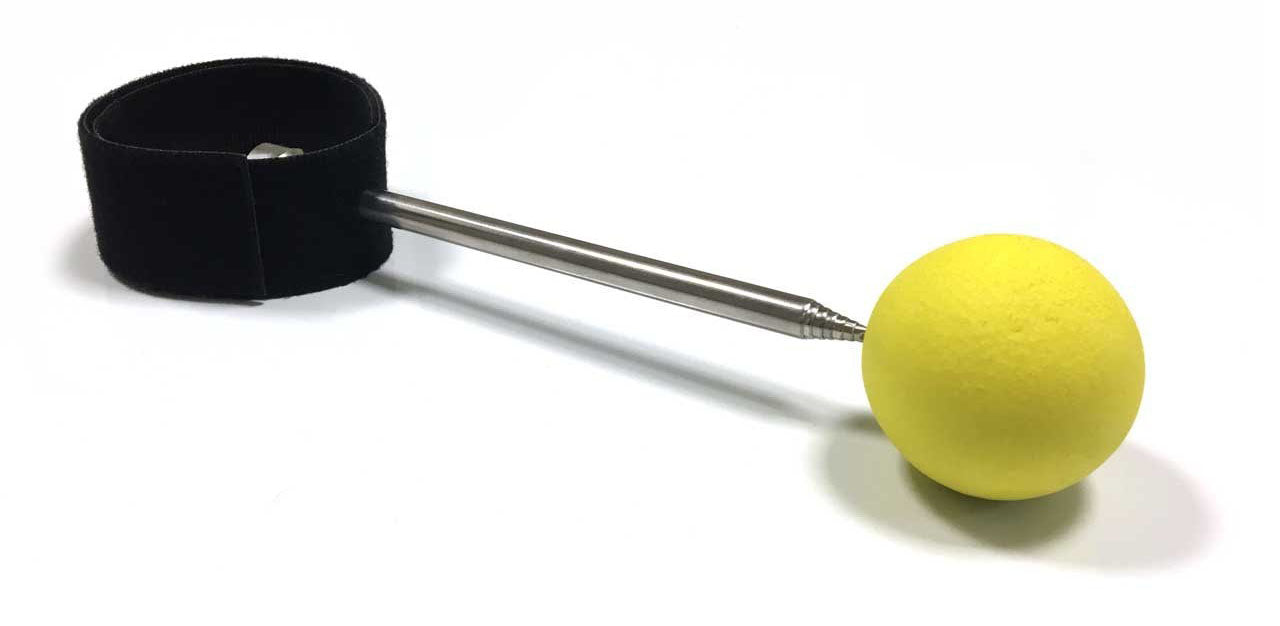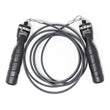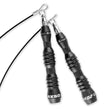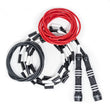What do AMRAPs, Fitaid, and No-Bulls have in common? Welp, they’ve all been popularized by the sport of functional fitness (also known as CrossFit). And there’s one more biggie to add to the list: double-unders.
The exercise gets its name because, wait for it...the jump rope needs to pass beneath your feet twice per rep. It’s math, Fam: 1 dub = 1 jump + 2 rope rotations. Got it? Okay cool, let's continue.
Double-unders may look like jumping rope on steroids and/or really, really, really fast single unders (just me?), but the explosive exercise is actually its own beast. “While classic jumping rope and double-unders are very similar in appearance, when done correctly, the tempo, timing, required coordination, and benefits are actually quite different,” says David Newman, certified L-1 CrossFit trainer and founder of CEO of Rx Smart Gear, the go-to rope brand of many CrossFit Games athletes.
So, sorry (!), but learning dubs is gonna be a lil' harder than bunny hopping at speed. But trust: The benefits of these babes are worth it. Scroll down to learn more.
How To Do Double-Unders
Before you even get jumping, you need to pick out the appropriately sized and weighted rope—yeppp there are ropes that are heavier than your regular school-yard recess variety. Newman says, “You want a three ounce rope that is your height plus three feet—but never longer than that.”
How to: Stand holding a jump rope with a loose, but firm, grip, thumb on top, forefingers below, palms facing forward. Step over rope so it’s behind your feet, which should be hip-width apart. Position your hands slightly in front of your body at hip-level, and tuck your elbows close to your sides.
Next, jump a few inches off the ground. When you’re in the air, rotate the rope under your feet twice with a flick of the wrist. Then, return your feet to the ground. That’s one rep.
To string reps together, rebound so that as soon as your toes hit the ground, you’re bopping back up into another rep.
Form tips: “Make sure you keep your head in a neutral position with your eyes forward or down at a 45 degree angle as you jump,” says Newman. This keeps your head in-line with your spine and prevents the position of your noggin’ from throwing off your balance.
“You want to your elbows bent and pointed backwards the whole time,” he says. If your arms start to look like windmills, sis, you’re only making things harder for yourself. (And double-unders are hard enough as it is, amirite?)
Also, try to keep your core engaged throughout the movement so you'll stay upright with lower-back in a neutral position and legs straight. Bringing your legs out in front may seeem like it’ll give you more time to whip the rope under your feet, but really, it’ll just throw off your balance and make it harder to string reps together, says Newman. So, “think about keeping a hollow-rock shape as you jump, this will keep you from shooting your legs out into a pike position,” he says.
How To Build Up To Double-Unders As A Beginner
Step 1: Ditch the rope. Can’t do ‘em yet? Toss your rope to the side. Really. “To master double-unders, you need to learn how to do each piece separately,” says Newman. Plus, “when you remove the jump rope, you remove the pressure and fear of failing, which helps people learn the prerequisite parts more quickly,” he says. Hey, whip-lash is no joke.
Step 2: Hone your hops. Next, work on your jump (which Newman calls your “bound”). “People mistakenly think that they need to whip the rope faster, but typically the problem is that they aren’t jumping high enough,” he explains.
Make a chalk line on a wall about six inches above eyes. Then practice jumping up through your toes (not your heels) so that your eyes drift above the line, says eight-time individual CrossFit Games veteran Stacie Tovar, co-owner of CrossFit Omaha. “Your toes should always stay underneath you and pointed down towards the floor, not forward and out in front of your body.” Pro tip: bend your knees a little every time you land to help absorb the shock.
Feeling fancy? Of course you are. Newman suggests investing in a bounding target, which you can secure to a squat rig to create a soft target about eight inches above your head. When you can consistently tap the target, or jump about six inches in the air, you’re ready to learn the arms/hands/wrists, he says.

Step 3: Get handsy. Keep the rope out of sight, and get into start position. Start jumping like the above, but this time when you’re in the air, “tap the sides of your thighs with your hands twice, like a penguin,” suggests Tovar. This will help you get used to the beat of dubs.
You can also invest in something called a tempo trainer, which is basically a shaker for jocks. “These produce an audible rattling sound to mimic the rope tapping the ground twice while airborne,” explains Newman.
Step 4: Just try ONE. It’s time to grab your rope. I know, F-I-N-A-L-L-Y. “From a dead standstill attempt a double-under without performing a single under first,” says Newman. Practice jumping high and turning the rope slowly to perform only one double-under at a time. Repeat after me: one.
Step 5: Get strung. Once you can consistently complete one dub at a time, try doing two at a time, then more.
“Focus on height rather than rope speed and give yourself permission to fail,” says Newman.
Benefits of Double-Unders
Hello, cardiovascular capacity, calves, core, and more. “Double-unders will boost the muscular endurance of everything from the forearms and biceps and shoulders and traps to the ankle tendons, calves, and hamstrings,” says Tony Carvajal, certified L-2 CrossFit trainer.
Not to mention:“There is a huge cardiovascular benefit to double-unders—your heart rate will jump way up right away and stay up.”
Oh, and jumping rope burns about 10 calories a minute, according to Carvajal. “Calories burned depend on how long and fast you do he double-unders for,” he says. And the longer you work the longer your heart rate will be elevated translating to burning more calories. But, “on average, an 150-pound person will burn 150 to 200 calories every 20 minutes,” says Carvajal.
Make Double-Unders Part Of Your Fitness Routine
Because dubs require advanced levels of coordination and consistency under an elevated heart rate, they’re considered a high-skill in CrossFit. So, if you’re new to double-unders, one of the best ways to use them is at the beginning of your workout when your legs and lungs are fresh.
Since they incorporate so many lower-body muscles and spike your heart rate, double-unders are also great for getting your blood pumping, and generally prepping your bod to sweat, says Carvajal.
Once you’re able to string 5 to 10 reps together in good form, you can try adding them into circuit-style workout. Just keep in mind that doing them under fatigue is going to make stringing them together harder. So, don’t get tripped up if you trip up.
Another option is to make hopping your whole workout. Accumulate as many double-unders as possible, jumping continuously at a steady pace for 5 or 10-plus minutes. Or, try one of Newman’s favorite double-under workouts for rope newbies below. Note: Once you become a double-under master you can make these even harder by getting a rope that weighs more than three ounces.
4 Double-Under Workouts To Try
1. String them Together: Do 10 reps in a row, unbroken. Complete 10 times for 100 total reps. Note: if you only get 7 reps in a row, those reps don't count. Only sets of 10 count towards the 100 tally.
2. Pacing Practice: Go from 5 slow double-unders into 5 fast double-unders. Complete 50 total reps.
3. Unbroken Ladder: For time, start with a set of 5 double-unders and then add 5 more for each additional set until you reach 50. Then, go down by 5 double-unders until you get back to 5. Complete each set without breaking. Rest for 30–60 seconds between sets.
4. Try the CrossFit WOD, "Annie" by doing 50-40-30-20-10 sets of double-unders followed by sit-ups in the say sequence. Reps do not need to be unbroken. Complete for time.








Leave a comment
This site is protected by hCaptcha and the hCaptcha Privacy Policy and Terms of Service apply.